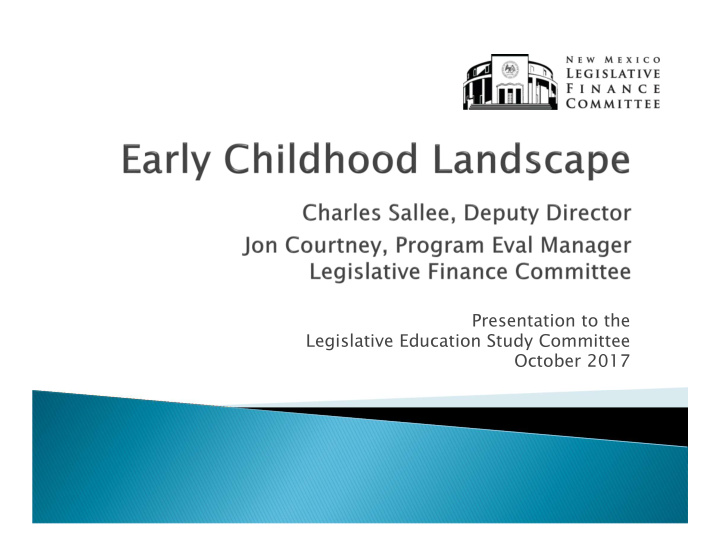



Presentation to the Legislative Education Study Committee October 2017
NM Indicators of child well being and performance Early childhood system structure and funding in NM Focus on 4 key programs today ◦ Home visiting ◦ Childcare ◦ PreK ◦ K3 Plus Discuss Policy Issues 2
3
4
Percent of Students Proficient on SY16 PARCC Reading Exam - All Grades 50.0% Persistently poor educational outcomes 40.0% Large achievement gap 30.0% 3 out of 4 third graders not proficient 20.0% Desire for “game 10.0% changing” policy and funding strategy to get 0.0% FRL and EL FRL no EL EL no FRL No FRL or better results EL Source: LFC Files Achievement gap is 1 in 5 kindergarteners at high poverty schools cannot identify a prevalent across grades single letter. 5
Recurring Early Childhood Funding History FY14-FY18 The Legislature has (in millions) $400 continued to increase $350 investments in early $300 childhood education $250 despite declining $200 revenues $150 $122 million (62 percent) $100 increase since FY14 $50 FY14 FY15 FY16 FY17 FY18 Head Start/ Early Head Start FIT Early Literacy K-3 Plus Prekindergarten Home Visiting Child Care Assistance 6
Early Childhood Funding (FY18) Head Start/ Child Care Early Head Assistance, Start, $67.0 $100.2 FIT, $43.4 Home Early Literacy, Visiting, $18.3 $12.5 K-3 Plus, PreK, $53.5 $23.7 7
Early Childhood Services: Proportion Total At Risk 4YO Population Served Child Care, 3,531 Unserved, 3,434 PreK, 9,254 Source: USDHHS, CYFD, PED, LFC At risk is defined as qualifying for free and reduced price lunch. Numbers reflect unduplicated services Head Start, 3,491 8
Home Visiting LFC estimates Need of (in millions) $20.0 5,985 slots at $22.8 $17.5 $18.3 $18.0 million $16.0 $14.3 HSD responding to GAA $14.0 $12.0 add of HV in Medicaid $10.6 $10.0 $8.1 Opportunity to close $8.0 $5.9 gap up to 77 cents on $6.0 $4.0 dollar using evidence- $2.3 $2.0 based practice $0.0 FY12 FY13 FY14 FY15 FY16 FY17 FY18 9
Child Care Assistance Costs and enrollment are (in millions) $120.0 up $96.6 $100.2 $100.2 $97.8 Evaluations of previous $95.6 $100.0 $87.2 ratings system showed no $82.9 $80.0 impact on ed outcomes 4-year enrollment up but $60.0 standards below PreK $40.0 Little research supporting child care as a child abuse $20.0 intervention $0.0 FY12 FY13 FY14 FY15 FY16 FY17 FY18 10
PreK PreK improves outcomes (in millions) $60.0 for children through 5 th $53.3 $52.1 $51.1 grade. $50.0 LFC looking at longer $40.0 $36.5 term outcomes now. $30.0 $30.0 Estimated $34 million $19.2 $20.0 $14.5 gap to cover all eligible $10.0 clients $0.0 FY12 FY13 FY14 FY15 FY16 FY17 FY18 11
Prekindergarten Participation and 5th Grade PARCC Proficiency 32% 31% 30% 29% 28% 27% 26% 25% 24% Prekindergarten No Prekindergarten Source: LFC Analysis of CYFD/PED data 12
Scientifically proven program when implemented with same teacher for 25 days Some evidence stacking eliminates achievement gap LFC has highlighted issues with implementation Significant gaps in funding ($69 million to cover total eligible clients) 13
Medicaid could eliminate funding gap for home visiting with affordable state match Need to grow implementation of evidence- based of evidence-based home visiting such as NFP, First Born, and others. If interested in improving educational outcomes then focus on other interventions besides child care ◦ until child care is proven to effect these outcomes, should we consider adding dollars to the program? 14
Decide expansion path for PreK ◦ Full day ◦ 3 year olds Consider enrolling 3 and 4 year olds in PreK rather than full time childcare and focus on after school funding rather than child care assistance for school age children What to do with Head Start Implement K3 Plus correctly in greater scale; align with PreK 15
Recommend
More recommend